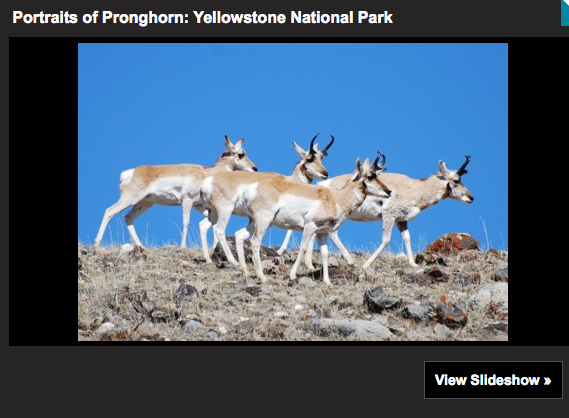 Pronghorn in Yellowstone's northern range on March 10, 2010 (photo by Beth Pratt)One of the delightful rites of spring in Yellowstone National Park is the annual gathering of pronghorn at the park’s north entrance. Every year a herd of pronghorn rendezvous in the meadows and hills near the famed Roosevelt Arch as they move to their summer range.
Pronghorn in Yellowstone's northern range on March 10, 2010 (photo by Beth Pratt)One of the delightful rites of spring in Yellowstone National Park is the annual gathering of pronghorn at the park’s north entrance. Every year a herd of pronghorn rendezvous in the meadows and hills near the famed Roosevelt Arch as they move to their summer range.
The nomadic pronghorns that inhabit the western United States wander long distances on their annually migration—research has shown movement up to 300 miles. Yet the migration of Yellowstone’s pronghorn—numbering roughly 300—has been sharply curtailed by human development as Tom Arrandale documents in a recent article for the National Parks Conservation Association, “Going Nowhere Fast.”
For the pronghorn herds that inhabit the park, a historical migration that once took the animals up the river canyon to nearby Paradise Valley in Montana has now been shortened considerably. Some of the pronghorn even forgo migrating and live year-round near the north entrance and Gardiner, searching out sustenance from the sparse forage during the winter months.
Pronghorn are truly remarkable animals. Called “speed goats” by Lewis and Clark, the fleet-footed creatures can sprint across a grassy steppe at speeds of up to 60 mph. As the fastest land mammal in North America, an adult pronghorn can outrun its predators; even a newborn fawn a couple of days after its birth can run faster than a human. Pronghorn are not true antelope, despite their mention in the well-known song, "Home on th Range," under that name.
Another spring arrival who Yellowstone locals enjoy greeting is a solitary pronghorn buck, alternatively nicknamed Peanut, Solo, or Andy by residents. In the spring and summer months he can often be seen grazing or napping contently in the grasslands and hillsides near Roosevelt Arch or on the lawns of some of the park’s historic structures outside of Gardiner.
Viewing pronghorn in Yellowstone: Pronghorn can be seen year-round at the park’s northern entrance, but are most noticeable during early spring on the Rescue Creek Trail and Old Gardner Road. In summer, the animals are often spotted in Lamar Valley as well.

